Munich Re: Climate change and its consequences – 18 of the 20 warmest years are in the period 2001-2018

By Dr. Eberhard Faust and Ernst Rauch
8 August 2019
(Munich Re) – When temperature records are broken or major weather disasters strike, people ask whether climate change has anything to do with it. One thing is clear: individual events themselves cannot be attributed directly to climate change. One needs to look at overall trends. The same is true for temperatures. Here are some generally accepted facts from climate science:
1. Climate change and greenhouse gases
- It is virtually certain that global warming, especially since the middle of the 20th century, has been primarily caused by mankind. Although fluctuations in the sun’s radiation intensity were partly responsible for warming in the first half of the 20th century, they do not explain the intense warming since then. In fact, in the last few years with the steepest increases in temperature, the sun’s radiation intensity has actually declined.
- Greenhouse gases such as carbon dioxide (CO2) absorb the Earth’s long-wave radiation and reflect a large part of this energy back towards the Earth’s surface. As the concentration of greenhouse gases rises, so does the energy content in the lower atmosphere (troposphere), which heats up. As well as the air in the lower atmosphere, the oceans also become warmer. The following is true of the portion of the long-wave radiation that is absorbed by greenhouse gases: the long-wave energy which is increasingly being redirected towards the Earth’s surface is missing in the radiation reaching the greenhouse gases in the stratosphere, a very high layer of the atmosphere. This is – in addition to the changes in the ozone content due to other causes – the second important reason why the entire stratosphere is cooling down long-term. Both trends, the warming “low down” (troposphere) and the cooling “high up” (stratosphere), have been recorded and measured for decades. They can only be explained by the greenhouse effect.
- Climate change is bringing more energy into the atmosphere. More water evaporates from warmer oceans, and a warmer atmosphere can absorb a greater volume of moisture. Among other things, these factors increase the potential for heavy rainfall. The increased amount of moisture in the atmosphere means more energy, which is released when the moisture condenses into clouds and the water subsequently freezes. This energy influences the water cycle and fuels convective processes. Regionally, for example in Europe and many other parts of the planet, climate change is also leading to more extreme heat events and in future probably to more agricultural droughts.
2. Global warming in figures
- All 18 years since 2001 rank among the 20 warmest since measurements began.
- The warmest was 2016. 2017 was also one of the three warmest years on record. But almost more important is the fact that 2017 was the hottest year ever recorded without the warming effect of the natural climate oscillation, El Niño. 2018 was similar, with global average temperatures 0.97°C above the 1880–1900 average, used as the benchmark for pre-industrial times.
- And in all of this, scientists see a clear signal of climate change.

3. Climate change and its effects
- Many scientists believe that climate change is influencing weather hazards such as heatwaves, droughts, extreme precipitation and storms in individual regions. But the link between them is complex: Natural climate oscillations exert a major – and over shorter periods frequently far greater – influence on weather hazards, and the vulnerability of buildings and infrastructure to natural events as well as the development of preventative structures and regulation also have a major effect on the scale of registered losses. When focusing on one single region and one individual weather hazard, the impact of climatic changes on losses since 1980 (adjusted to take account of rising values) can be identified in some cases. On a global scale, however, such impacts would not show up due to the countervailing influences partially cancelling each other out.
- New research methods enable scientists to state whether in a specific region extreme events such as rain above a certain amount or temperatures above a certain threshold have become more – or less – likely compared with a world without climate change. The results of these so-called attribution studies are of enormous help in the early identification of risk drivers and thus also in planning adaptation and loss prevention measures. Such regional studies have thus far been carried out on heat, drought, precipitation and floods, oceanic parameters, cold and storms – although the majority of studies have looked at temperature extremes. For example, the studies have revealed that the probability of severe flooding events in certain regions of Great Britain has increased significantly compared with a world without climate change. Of 131 extreme events in different parts of the world investigated in peer-reviewed studies by one scientific journal, 68% revealed an influence of climate change on altered exceedance probabilities. Many extreme events are therefore already being influenced by climate change.

4. Examples of natural hazards that indicate an existing, assumed or future influence of climate change
- Severe thunderstorms in North America: Losses from severe thunderstorms with hail, gusts, tornadoes or torrential rain are rising, even after taking increasing values into account. This trend tallies with changes in meteorological data and in particular the increase in moisture in the lower atmosphere, which studies have identified as the most significant influencing factor. As the increased moisture content is due to the rising air temperatures and the consequently warmer ocean surfaces, this strongly indicates the influence of climate change. And this also correlates with what scientists expect as a consequence of climate change.
- Severe thunderstorms in Europe: As in North America, normalised losses have increased significantly here. Studies show that in parts of Europe, including southwest Germany, northern Italy and the Alpine countries, severe thunderstorms with hail have already increased; again, the increase in moisture in the lower troposphere is one of the main reasons for this. Such a change is a consequence of rising temperatures. Greater loss susceptibility of buildings fitted with sensitive thermal insulation, solar installations and expensive metal façades is also driving up loss potentials. The costliest single thunderstorm event since 1980 occurred in Germany in July 2013, when powerful hailstorms in particular caused overall losses of €4.6bn in today’s values. About €3.5bn of this was insured.
- Wildfires in California: Observation data on the increase in large individual fires and studies on its possible causes suggest that climate change is making a significant contribution to the rising wildfire risk and major wildfire losses in California. The largest wildfires recorded in California since the 1930s have predominantly occurred since the beginning of the new millennium. The same period also experienced the most years with exceptionally high temperatures and unusually dry conditions. Recent studies have shown that many other regions of the world have also experienced an increase in the environmental conditions that can cause wildfires, including the Mediterranean and parts of Australia. (Find out more here)
- Monsoon and heatwaves in South Asia: In South Asia, and particularly in India, heatwaves are now the events that bring about the most drastic humanitarian consequences. Often, thousands of people die in these summer heatwaves, when temperatures can reach well over 40°C. Scientists consider it “probable” that climate change will bring more frequent and more severe heatwaves to South Asia. It has already been established that the periods of extreme heat have become longer there. The IPCC expects climate change to influence monsoon rainfall in the future. For example, in India average rainfall during the monsoon period is likely to increase slightly, as will fluctuations between seasonal precipitation highs and lows, which would pose a huge problem for agriculture. At the same time, extreme rainfall events are expected to increase. In summary: higher seasonal variability and more extremes.
- Flooding – Uncoupling of meteorology and losses: In Europe, the overall trend in losses (after adjustment for increases in values) has fallen – primarily thanks to improved loss prevention. Nevertheless, and this is significant for the future, scientists are convinced that climate change is influencing precipitation patterns in Europe and will produce heavy rainfall and flash floods more frequently – coupled with a tendency for longer dry phases to occur in Europe and elsewhere. On a global average, heavy rainfall has already increased. According to projections by the IPCC, there will also be more extreme river flooding in many regions. Studies on the US Gulf Coast have revealed that the probability of extreme three-day rainfall, as witnessed in Louisiana in August 2016 (overall losses US$ 10bn) or in August 2018 during Hurricane Harvey, has already increased by a factor of at least 1.4–1.5 as a result of climate change.
- Over the last few years, there have been several examples of severe river flooding in central Europe, for example in 2013. In terms of its meteorological/hydrological characteristics, the flooding was similar to the Elbe floods of 2002, but caused a third less damage. This can no doubt be explained by the billions invested in flood protection in Germany and neighbouring countries following the Elbe floods of 2002. Money well spent! In North America and China too, there are indications that massive investment in flood protection on rivers has led to a reduction in normalised losses.
- Tropical cyclones in the North Atlantic and other ocean basins: In the tropical North Atlantic, storm activity is heavily influenced by natural climate oscillations, such as the persistent warm and cold phases in the North Atlantic over many decades (Atlantic Multidecadal Oscillation), or by teleconnection effects from the ENSO climate oscillation in the Pacific – better known as El Niño and La Niña. Since the last warm phase began in the mid-1990s, there has been a higher variability in the number of major hurricanes per season – but no trend. In some ocean basins, there has for several decades been a poleward shift in the latitude at which tropical cyclones generally reach their maximum intensity on average. A causal connection to climate change of this observed shift has already been analysed for the western part of the North Pacific; it is projected to continue in the future. Cautious statements are possible regarding the future of tropical cyclones: as a result of climate change, scientists expect an increase in the number of severe storms.
Greater protection against the consequences of natural disasters is urgently needed to prevent the unchecked growth of their humanitarian and financial impact. Insurance cover can go some way to cushioning the financial losses and strengthening resilience to shock events, which would clearly benefit the individuals and economies affected.


